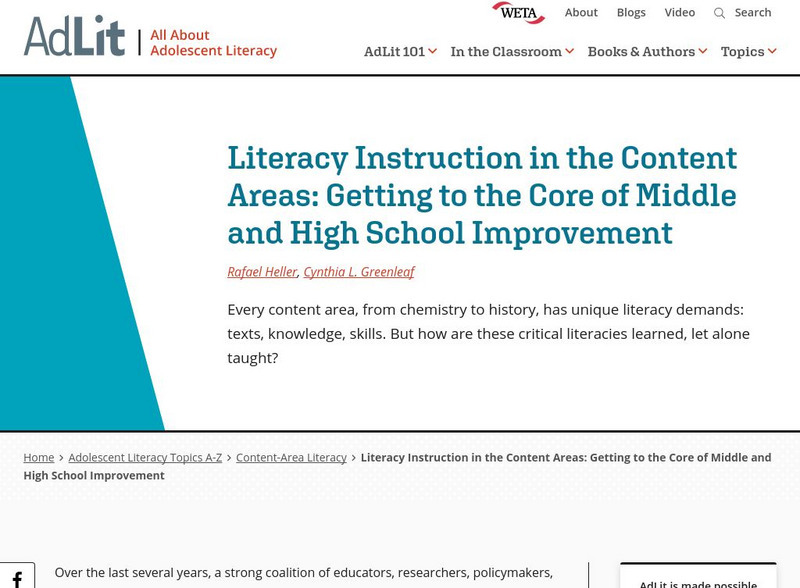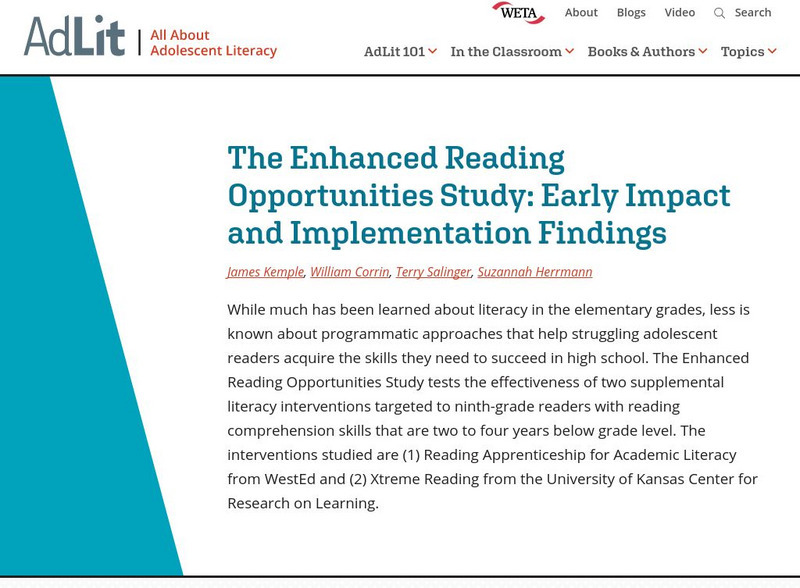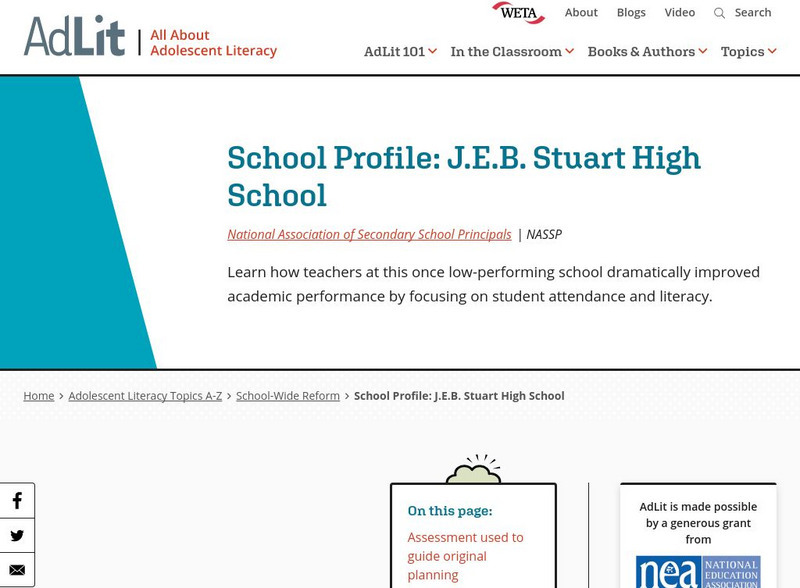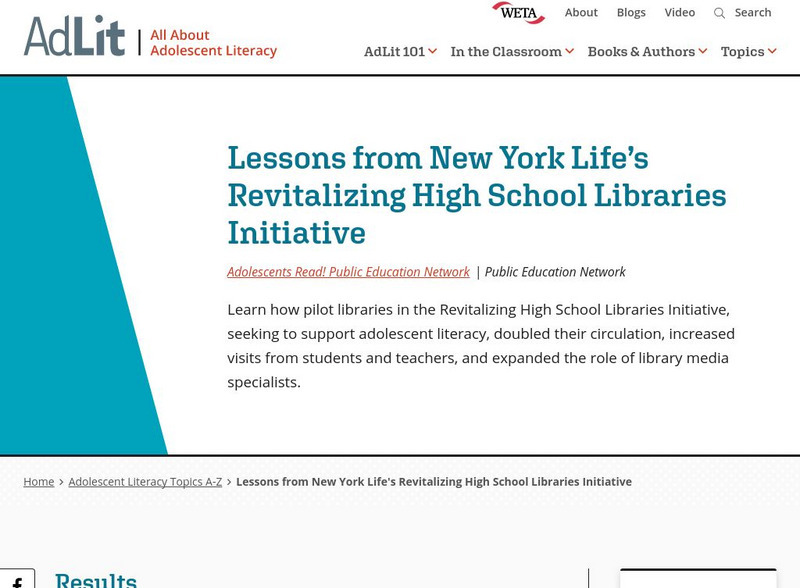AdLit
Ad lit.org: Organizations That Promote Adolescent Literacy
From lesson plans and classroom tools to free books and opportunities to publish students' work, nonprofit organizations have a lot to offer parents, teachers, and struggling readers themselves. Learn about some nonprofits with a...
AdLit
Ad lit.org: Adolescent Literacy: What's Technology Got to Do With It?
Learn how technology tools can support struggling students and those with learning disabilities to acquire background knowledge and vocabulary, improve their reading comprehension, and increase their motivation for learning.
AdLit
Ad lit.org: Sustaining Focus on Secondary School Reading: Lessons, Recommendations
Alabama is unique in including an adolescent literacy focus in its statewide reading improvement efforts. This report from the National High School Center looks at the Alabama Reading Initiative and synopsizes 10 lessons learned in...
AdLit
Ad lit.org: Key Literacy Component: Text Comprehension
Text comprehension allows readers to extract or construct meaning from the written word. Students who misread words or misinterpret their meanings are at a disadvantage. Proper instruction can boost students' skills in this key area.
AdLit
Ad lit.org: Content Area Literacy: Science
The demands of comprehending scientific text are discipline specific and are best learned by supporting students in learning how to read a wide range of scientific genres. Besides text structures emphasizing cause and effect, sequencing...
AdLit
Ad lit.org: Key Literacy Component: Decoding
Decoding is the ability to correctly decipher and identify a word from a string of letters. Students who struggle with decoding are at a disadvantage, but explicit instruction can help them learn this skill.
AdLit
Ad lit.org: Key Literacy Component: Writing
Students who don't write well aren't able to learn and communicate effectively. This article explains what good writing skills are and how to help struggling young writers gain those skills through proper instruction.
AdLit
Ad lit.org: Key Literacy Component: Morphology
Morphology describes how words are formed from building blocks called morphemes, the smallest unit of meaning in a word. Students who don't understand this structure have trouble recognizing, understanding, and spelling words. Find out...
AdLit
Ad lit.org: Key Literacy Component: Fluency
Fluent readers can read text accurately, smoothly, and with good comprehension. Students who get bogged down in the mechanics of reading have trouble with this skill. With proper instruction, struggling readers can improve their fluency.
Other
Why the Crisis in Adolescent Literacy Demands a National Response
Though it is a position paper, this document does lay out a basic set of strategies to aid struggling adolescent readers. It also includes a list of references for further information. From Alliance for Excellent Education.
AdLit
Ad lit.org: Professional Development Helps Support Adolescent Literacy
Learn about several efforts underway to increase the training and professional development options available to out-of-school-time staff, including seasonal workers.
American Institutes for Research
Center on Response to Intervention: Secondary Literacy: Life Changing Results
This 2007 brief provides an orientation to the Content Literacy Continuum (CLC) model a replicable district-level model of instruction to meet the differentiated needs of struggling adolescents. CLC is a five-level model that is aligned...
AdLit
Ad lit.org: Literacy Instruction in the Content Areas: The Core of Improvement
Every content area, from chemistry to history, has unique literacy demands: texts, knowledge, skills. But how are these critical literacies learned, let alone taught?
AdLit
Ad lit.org: Literacy Coaching in the Middle Grades
From time constraints to a de-emphasis on literacy to a limited research base, coaches in middle schools face challenges that do not exist in the elementary grades.
Other
Help Your Teen Build Literacy Skills [Pdf]
Here you'll find tips for parents to help boost the literacy of teens at home. Requires Acrobat Reader.
AdLit
Ad lit.org: The Enhanced Reading Opportunities Study
While much has been learned about literacy in the elementary grades, less is known about programmatic approaches that help struggling adolescent readers acquire the skills they need to succeed in high school. The Enhanced Reading...
Texas Education Agency
Texas Gateway: Teaching Adolescents Who Struggle With Literacy
There are five components of reading instruction for struggling adolescent readers: Word identification/decoding, Vocabulary, Comprehension, Fluency, and Engagement/motivation. These components are discussed and a video of middle school...
AdLit
Ad lit.org: Time Is Not on Our Side: Literacy and Literature for High School El Ls
Given that teachers often have too much to teach and too little time, teacher Dana Dusbiber suggests an alternative approach to teaching literature for secondary ELLs: the introduction of more multicultural literature in the classroom.
AdLit
Ad lit.org: Key Literacy Component: Vocabulary
What's in a word? Mastery of oral and written vocabulary promotes comprehension and communication. Find out how proper instruction can help students who struggle with vocabulary.
AdLit
Ad lit.org: School Profile: j.e.b. Stuart High School
Learn how teachers at this once low-performing school dramatically improved academic performance by focusing on student attendance and literacy.
AdLit
Ad lit.org: Reading Next
Millions of today's adolescents lack the reading skills demanded by today's world. The impending crisis - millions of under-literate young people unable to succeed economically and socially - requires an immediate response. This report...
AdLit
Ad lit.org: Lessons From Ny Life's Revitalizing High School Libraries Initiative
Learn how pilot libraries in the Revitalizing High School Libraries Initiative, seeking to support adolescent literacy, doubled their circulation, increased visits from students and teachers, and expanded the role of library media...
AdLit
Ad lit.org: A Closer Look: Closing the Performance Gap
The performance gap - what students are expected to do versus what they can do - is compounded each year a child falls short of acquiring expected skills. As a result, underachieving high school students are at great risk for academic...
AdLit
Ad lit.org: A Theory of Adolescent Reading: A Simple View of a Complex Process
How do adolescents move from reading words to applying knowledge learned from a text? See the adolescent reading model and the Strategic Intervention Model (SIM) clearly illustrated.














![Help Your Teen Build Literacy Skills [Pdf] Unit Plan Help Your Teen Build Literacy Skills [Pdf] Unit Plan](https://static.lp.lexp.cloud/images/attachment_defaults/resource/large/FPO-knovation.png)








